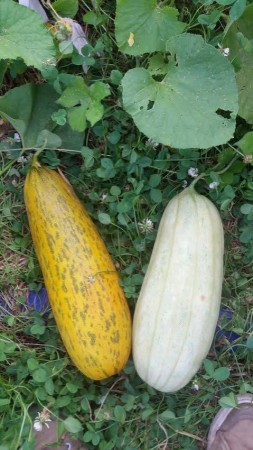 This photo accompanies a Facebook post on the page of the Experimental Farm Network, an initiative “dedicated to facilitating participatory plant breeding and other collaborative agricultural projects.” Now, I don’t understand Facebook enough to know who will actually be able to see the post, so I’ll reproduce it here:
This photo accompanies a Facebook post on the page of the Experimental Farm Network, an initiative “dedicated to facilitating participatory plant breeding and other collaborative agricultural projects.” Now, I don’t understand Facebook enough to know who will actually be able to see the post, so I’ll reproduce it here:
Our first two “Hithadhoo Melons” from Hithadhoo, Laamu atoll, in the Maldives! These two very different looking melons came from the same packet of seeds we received through the USDA (PI 536482). We picked them yesterday because they were starting to split, likely due to the immense rain of last week, followed by the intense heat of this week here in NJ.
The USDA collected this in 1986, but it was listed as a cucumber until 1999 when they correctly re-id’d it as a melon. When the fruit are still small, they do look and taste very much like cucumbers. We’re letting these sit for a bit to continue ripening before we crack them open to see what they’re like inside. We plan to reach out to folks in the Maldives to learn what they call this melon, what they use it for, how they grow it, etc. Hithadhoo is one of the largest islands in the archipelago.
After putting off these two early on, plus a couple other large fruit still on the vines, the plants are suddenly putting off tons of female flowers, meaning many more fruit are on the way. It seems likely each plant could produce a dozen or more full-size melons before the season is through. Hand-pollination has been relatively easy with this one too, even in the afternoon (some cucurbits are only fertile in the morning). This one definitely seems like a winner.
Just one more reason why it’s a shame the Maldives are likely to slip beneath the waves before this century is through.
What intrigues me here is whether the North Central Regional PI Station at Ames, Iowa, which is where PI 536482 is conserved, know about this. Because I bet they’d be really interested to know all about how those Maldivian melons are doing in New Jersey.
There must be a way to monitor the internet for references to PI numbers. Right? Some clever way of setting up a Google Alert that returns only instances of the string “PI” followed by numbers (perhaps with a space in front), perhaps?
Thanks for posting this. We’re clearly excited about these interesting melons. At the end of the season we plan to compile information on everything we grew this year and last to report back to the USDA. This not only helps their science, but also helps them justify their budgets in the inevitable DC budget fights ahead. It’s important for people who use this unique and critically important resource (the National Plant Germplasm System) to lay out and explain what’s so special about it. These melons are just the tip of the iceberg.
I’ll let them know you said that.
Maldives is an interesting place for watermelons. I worked on the island of Thoddoo (in Alif Alif Atoll) back in the nineties on an IPM programme for watermelons. Thoddoo is the largest producer of watermelons (or was?) in the Maldives, strategically targeting the demand during the holy month of Ramadan in nearby Male. Can put you in touch with a few people if need be.
Luigi:
You can set up a Google Alert just as you’ve indicated. For what its worth I just discovered a couple features Google Alert has now that were not available the last time I set one up. So thanks for that.
I also tried a plain ol’ fashioned Google search for this PI with and without a space between ‘PI” and the number. Both worked fine (and this particular post popped up as the first ‘hit’ in my browser).
Nate’s point about sharing the value of this resource is spot on!
I always thought this taxon was an exotic one. Used to be common in the market but rarely seen now. A very interesting plant indeed.